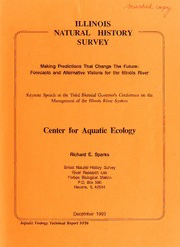
Making predictions that change the future: forecasts and alternative visions for the Illinois River : Keynote speech at the Third Biennial Governor's Conference on the management of the Illinois River System PDF
Preview Making predictions that change the future: forecasts and alternative visions for the Illinois River : Keynote speech at the Third Biennial Governor's Conference on the management of the Illinois River System
yiyi^M^jUL c^^tLt;, ILLINOIS ^==\ f NATURAL HISTORY SURVEY Making Predictions That Chang© The Future: Forecasts and Alternative Visions for the Illinois River Keynote Speecli at tlie Tliiid Biennial Guvenior's Conference on the Management of tlie Illinois River System Center for Aquatic Ecology Richard E. Sparks Illinois Natural History Survey River Research Lab Forbes Biological Station P.O. Box 590 Havana, IL 62644 ^ December 1993 Aquatic Ecology Technical Report 93/18 'TtulaJuJ- MAKING PREDICTIONSTHATCHANGETHE FUTURE: FORECASTS AND ALTERNATIVE VISIONS FORTHE ILLINOIS RIVER Keynote Speech Third Biennial Governor's Conference on the Management of the Illinois River System Hotel Perc Marquette Peoria, Illinois 21-22 September 1993 Presented by Richard E.Sparks River Research Laboratory of the Stephen A.Forbes Biological Station Illinois Natural History Survey Havana, IL 62644 Text prepared 4 January 1994 IllinoisNaturalHisiorySurvey CenterforAquaticIxology TechnicalRcpc-rt93/18 Making Predictions That Change The Future: Forecasts and Alternative Visions for the Illinois River Keynote Speech attheThirdBiennialGovernor's Conference ondieManagementoftheIllinoisRiverSystem by Richard E. Sparks IllinoisNaturalHistorySiu^'cy RiverResearchLaborator)' ForbesBiologicalStation P.O.Box590 Havana,IL 62644 RRiicchhaarrddEE..SSppaarrkkss 7/ DavidP.Philipp,Director PrincipalInvestigator CenterforAquaticEcology This paper originally was presented as a keynote address at the Third Biennial Governor's Conference on the Management of the Illinois River System, Hotel Pere Marquette, Peoria, Illinois, 21-22 September 1993. It was published in the proceedings of the conference in 1994 by the University of Illinois Water Resources Center. Copies of the proceedings are available from: Heartland Water Resources Council of Central 111inois Commerce Bank Building 415 Main Street, Suite 828 Peoria, Illinois 61502-1115 This paper should be cited as: Sparks, R.E. 1994. Making predictions that change the future: forecasts and alternative visions for the Illinois River. Holly Korab, ed. Proceedings of the Third Biennial Governor's Conference on the Management of the Illinois River System, Peoria, IL, 21-22 September 1993. Sparks 1 January 1994 Page 1 ABSTRACT The Illinois River ranks among a world class of large river-floodplain ecosys- tems that includes the Mississippi, the Amazon, and the Nile. These rivers are dynamic ecosystems characterized by seasonal floods that spread over large floodplains and enhance biological productivity. Despite a century of altera- tions, the Illinois River retains approximately half its floodplain and a floodpulse, and therefore is one of only three large river-floodplain ecosys- tems in the United States recommended for restoration by the National Research Council Committee on Restoration of Aquatic Ecosystems (1992). It is part of the Upper Mississippi River System, which Congress recognized as a "nationally significant ecosystem" in the Water Resources Development Act of 1986. Al- though no restoration can ever be perfect, it is possible to restore processes that enable a disturbed ecosystem to maintain, repair, and even rejuvenate itself. Impediments to restoration include incomplete public ownership of underwater lands needed for restoration projects; continuing invasions of nonnative pests such as the zebra mussel; and toxic episodes that can undo many years of pollution abatement and ecosystem recovery. These obstacles can be overcome by easements or purchase of land; by stricter federal regulations and better dispersal barriers; and by new continuous biological monitoring systems that provide early warning of toxicity so that corrective action can be taken. The predisturbance reference period for the Illinois should be the 19th century, when the river maintained itself in a dynamic equilibrium with no human intervention, rather than more recent periods when the river was disequilibrated by watershed alterations, Lake Michigan diversion, and naviga- tion dams. Much can be learned from retrospective analysis of available data on predisturbance land forms, vegetation patterns, and hydrographs that could be applied to contemporary restoration of the river. Current efforts to rehabilitate and enhance portions of lakes or lands for a particular human use or highly valued species are expensive, interim measures that require continu- ing maintenance and may, in fact, worsen the excessive sedimentation and water level fluctuations they seek to mitigate. Ecosystem restoration saves money in the long run, because natural services are restored, instead of requiring costly human intervention with its considerable risk of failure. These serv- ices include self-repair following natural or human disturbance; flood convey- ance and storage; water purification; fish and wildlife production; and pres- ervation of biodiversity.
